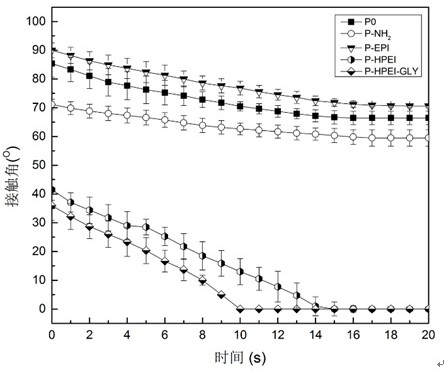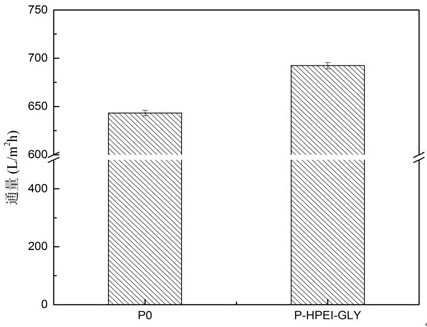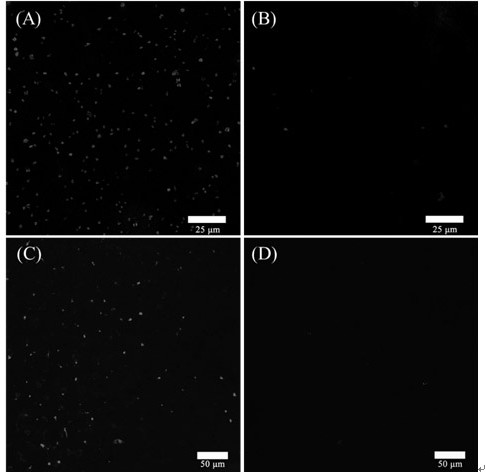A kind of preparation method of superhydrophilic modified antifouling PVDF separation membrane
A separation membrane, anti-pollution technology, used in semi-permeable membrane separation, chemical instruments and methods, osmotic/dialysis water/sewage treatment, etc., can solve problems such as strong hydrophobicity, achieve durable anti-pollution performance, easy industrial implementation, Easy to operate effect
- Summary
- Abstract
- Description
- Claims
- Application Information
AI Technical Summary
Problems solved by technology
Method used
Image
Examples
Embodiment 1
[0028] Soak the PVDF separation membrane in clean water for 24 hours to remove impurities on the surface of the PVDF separation membrane (denoted as P0). Place the pretreated isolate membrane in a polytetrafluoroethylene closed box (single-sided reaction box), configure 1M 1,4-butanediamine and dissolve it in a sodium carbonate buffer solution (adjust pH=11.0), 200rpm , and reacted at 25°C for 12 hours until a light yellow ammonium salt compound layer appeared on the membrane. After that, it was washed alternately with water and ethanol for 24 hours, and dried in vacuum at 40°C to obtain a PVDF separation membrane modified by the first step (denoted as P-NH 2 ). The resulting membrane P-NH 2Soak it face up in 150mL of absolute ethanol, add 3mL of epichlorohydrin dropwise, protect the device with nitrogen, slowly add 40mg of benzyltriethylammonium chloride, react at 100rpm, 65°C for 5h, and then 5 mL of 0.06M sodium hydroxide solution was added dropwise, and the reaction was...
Embodiment 2
[0030] Soak the PVDF separation membrane in clean water for 24 hours to remove impurities on the surface of the PVDF separation membrane (denoted as P0). Place the pretreated isolate membrane in a polytetrafluoroethylene closed box (single-sided reaction box), configure 1M 1,4-pentanediamine and dissolve it in a sodium carbonate buffer solution (adjust pH=11.0), place In a shaker, react at 200 rpm and 25° C. for 12 hours until a light yellow ammonium salt compound layer appears on the membrane. After that, it was washed alternately with water and ethanol for 24 hours, and dried in vacuum at 40°C to obtain a PVDF separation membrane modified by the first step (denoted as P-NH 2 ). The resulting membrane P-NH 2 Soak it face up in 150mL of absolute ethanol, add 3mL of epichlorohydrin dropwise, protect the device with nitrogen, slowly add 40mg of benzyltriethylammonium chloride, react at 100rpm, 65°C for 5h, and then 5 mL of 0.06M sodium hydroxide solution was added dropwise, a...
Embodiment 3
[0032] Contact angle test: Use a contact angle tester to test the contact angle of water on the PVDF membrane surface.
[0033] After testing, the P0 contact angle of the film obtained in Example 1 was 85-95°, and after modification, the contact angles of the P-HPEI and P-HPEI-GLY films decreased significantly to 30-40° compared with the film P0, and decreased within 15s. to 0°, which proves that the modified membrane has good hydrophilicity.
PUM
 Login to View More
Login to View More Abstract
Description
Claims
Application Information
 Login to View More
Login to View More - R&D
- Intellectual Property
- Life Sciences
- Materials
- Tech Scout
- Unparalleled Data Quality
- Higher Quality Content
- 60% Fewer Hallucinations
Browse by: Latest US Patents, China's latest patents, Technical Efficacy Thesaurus, Application Domain, Technology Topic, Popular Technical Reports.
© 2025 PatSnap. All rights reserved.Legal|Privacy policy|Modern Slavery Act Transparency Statement|Sitemap|About US| Contact US: help@patsnap.com



